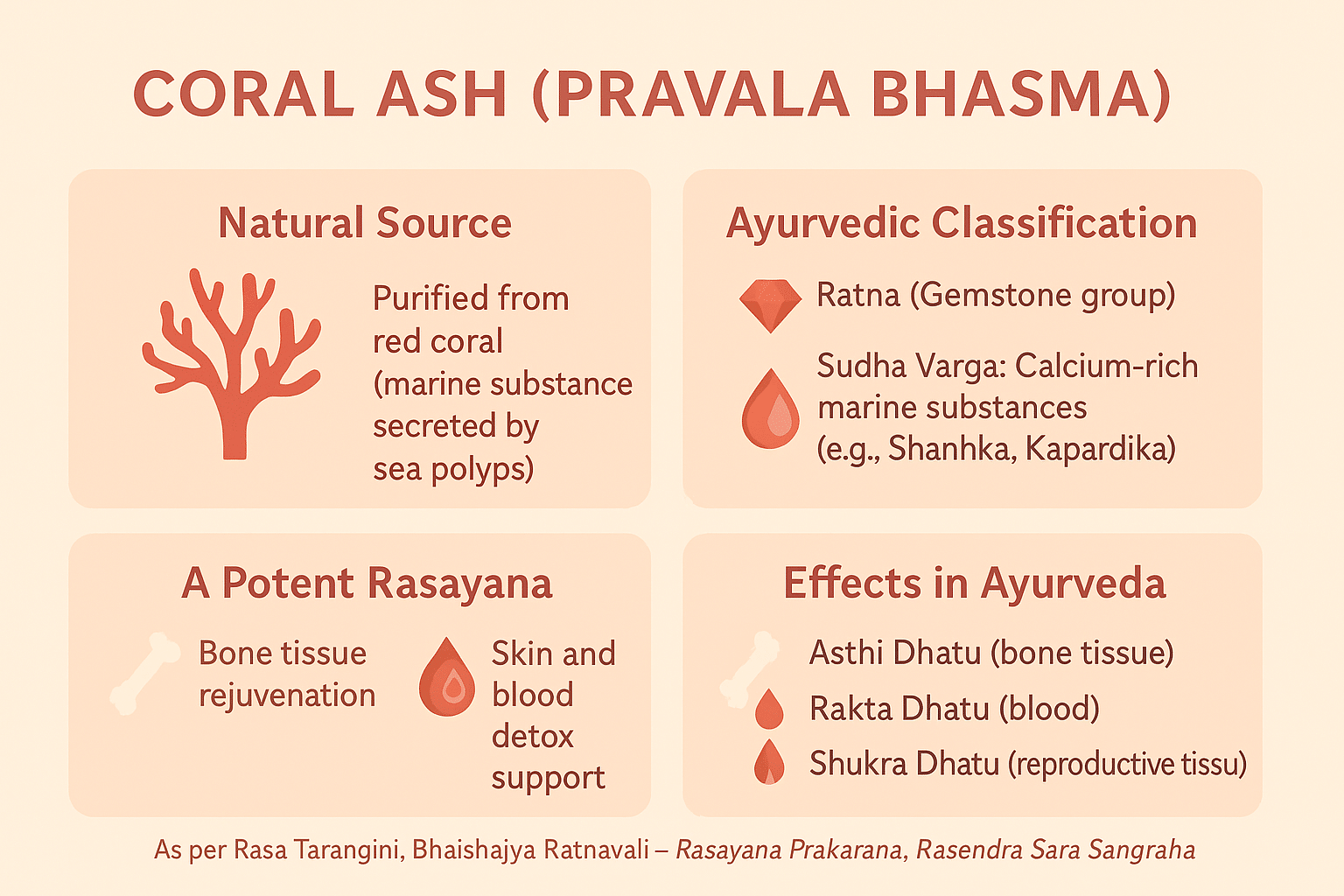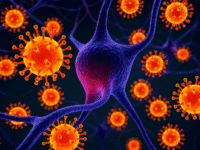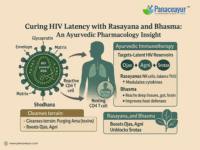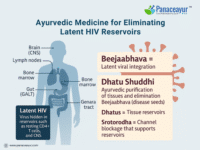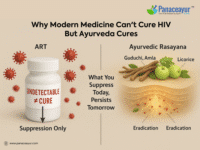- Preparation Of Coral Bhasma
- Rasa, Guna, Veerya, Vipaka, and Dosha Action
- Dhatu and Srotas Affiliation
- Therapeutic Uses of Coral Ash (Pravala Bhasma)
- Neutralizes Acidity, Ulcers, and Acidic Throat Conditions
- Reduces Skin Inflammation and Clears Heat from the Blood
- Regulates Menstrual Health and Reduces Uterine Heat
- Improves Male Reproductive Function and Sperm Quality
- Soothes Vomiting, Burning Sensation, and Excessive Thirst
- Supports Eye Health in Heat-Sensitive Disorders
- Used in Pitta-Type Headache and Migraine
- Cools the Urinary Tract and Alleviates Burning Urination
- Safe for Children, Pregnant Women, and the Elderly
- A Rasayana for Systemic Rejuvenation
- Dosage, Anupana, and Safety Guidelines
- Appropriate Anupana Based on Disease and Dosha
- Safety Guidelines and Clinical Toxicology
- Contraindications and Clinical Cautions
- Physician Insights and Usage Tips
- Classical Formulations
- Kamdudha Ras- Core Remedy for Pitta and Rakta Disorders
- Mukta Panchamrit Ras- Multi-Bhasma Protocol for Acid and Heat Syndromes
- Praval Pishti- Preferred in Sensitive Patients and Ophthalmic Cases
- Sootshekhar Ras:-Acid–Migraine Bridge Formula
- Ashokarishta and Pushyanuga Churna- Menstrual Balance and Uterine Heat
- Pediatric Rasayanas- Teething, Sweating, and Fever Recovery
- Patolakaturohinyadi Kashaya and Sarivadi Vati- Heat Skin Detox
- Gokshuradi Guggulu and Chandanasava- Urinary Heat and Burning
- Raktapitta and Hemorrhagic Syndromes- Internal Bleeding Control
- Prameha (Diabetes with Pitta Signs)-Burning, Ulcers, and Thirst
- Pharmacological Properties and Biomedical Research
- Ayurvedic pharmacodynamics of Pravala Bhasma
- Bioavailable calcium and safe assimilation
- Bone healing and osteogenic effects
- Gastroprotective and anti-ulcer action
- Hemostatic and anti-inflammatory activity
- Antioxidant and neuroprotective potential
- Synergistic Combinations
- Strategic herbal and mineral pairings with Pravala Bhasma
- Pravala and Mukta Bhasma for upper-body heat and bleeding
- Pravala and Shankha Bhasma for gastro-acid disorders
- Pravala with Guduchi and Giloy Satva for systemic pitta clearing
- Pravala and Ashwagandha for bone and hormonal health
- Pravala and Arjuna for cardiovascular heat and anxiety
- Pravala and Yashtimadhu for ulcer and bleeding relief
- Anupana: Ideal carriers for optimal delivery
- Safety, toxicology, and contraindications
- Mentions in foundational Ayurvedic texts
- Bhaishajya Ratnavali and therapeutic emphasis
- Rasatarangini’s pharmaceutical clarity
- Classical formulas featuring Pravala
- Commentarial perspectives from Nighantus and Samhitas
- References
Pravala Bhasma, also known as Coral Ash, is a time-honored Ayurvedic mineral preparation derived from purified red coral—organically secreted by marine polyps. It is categorized as a Shankha-jati Ratna (gem-like marine substance), and more precisely, under the group of Uparatna and Sudha Varga Dravyas, known for their high calcium content and Pitta-pacifying nature [1].
In classical Rasa Shastra, Pravala is described as a cooling agent that deeply nourishes Asthi Dhatu (bone tissue) and purifies Rakta Dhatu (blood) while supporting Shukra Dhatu (reproductive fluid) and calming excess heat in Pitta-pradhan conditions [2]. Its synonym Rakta-Mukta (“red pearl”) emphasizes its jewel-like origin and energetic cooling potency.
The Rasa Tarangini clearly states:
“Pravalam shuddham rasayanam, pittashamanam balapradam”
(“Purified Pravala acts as a Rasayana, pacifies Pitta, and strengthens the body”) [3].
Additionally, Bhaishajya Ratnavali – Rasayana Prakarana recommends Pravala for conditions like Amlapitta, Raktapitta, Kshaya, and Pradara, especially when Pitta disturbs Rakta and Asthi Dhatus [4]. These uses are further confirmed in Rasaendra Sara Sangraha, which emphasizes its utility in eye diseases, hyperacidity, and skin conditions.
During Shodhana, raw coral is immersed in lime water, then treated with sour liquids like Kanjika or Kumari Swarasa to neutralize its marine toxicity. After this, Marana (calcination) is performed using Gajaputa Agni, yielding a soft red Bhasma that undergoes classical tests such as:
- Varitaratva (floats on water)
- Rekhapurnata (enters skin lines)
- Apunarbhava (irreversible transformation)
[5]
By transforming raw coral into this bioavailable ash, Ayurveda unlocks its deeper Rasayana potential. Unlike crude calcium, this form binds better with Agni and integrates into cellular metabolism, especially in weakened or aging tissues.
Thus, Pravala Bhasma is not just a calcium source—it is a cooling Rasayana with targeted effects on bone loss, blood toxicity, reproductive depletion, and heat-induced inflammatory disorders [6].
Preparation Of Coral Bhasma
Shodhana and Marana (Purification) Process
In Ayurvedic pharmaceutics, raw Pravala (red coral) must undergo classical purification and incineration before becoming therapeutically suitable. These two stages—Shodhana (purification) and Marana (calcination)—are essential to detoxify marine impurities and transform the coral into a soft, absorbable ash form known as Pravala Bhasma [1].
Shodhana: Detoxification and Cooling
Shodhana is performed to remove salts, toxins, and organic impurities embedded in raw coral. Without this step, coral retains marine residues that may aggravate Pitta or harm digestion.
Classical methods of Shodhana include:
- Immersion in Nimbu Swarasa (lemon juice) or Kanjika (fermented rice gruel) for 1–3 days
- Cow’s milk or Gulab Jala (rose water) may be added for added Pitta-pacifying effect
- Coral is rubbed and stirred until it becomes clean, light, and slightly soft to touch
This process is mentioned in Rasa Tarangini, which recommends repeated dipping in acidic media to neutralize coral’s oceanic hardness and to infuse Sheeta Virya (cool potency) [2].
Marana: Incineration for Bioavailability
Marana is the transformation of coral into ash through controlled fire exposure. This step converts coral’s calcium carbonate (CaCO₃) into a nano-fine Bhasma, which is easily absorbed by the body.
Traditional Marana process includes:
- Bhavana (wet grinding) of purified Pravala with Kumari Swarasa (aloe juice) or Rose Water
- Placing in sealed earthen pots (Sharava Samputa) and drying
- Heating in a Gajaputa Agni (standard cow dung cake pit for calcination)
- Repeating this 2–3 times until a soft pinkish Bhasma is formed
In Bhaishajya Ratnavali – Rasayana Prakarana, it is noted:
“Pravalam mritam pittaghna rasayanam balapradam”—
“When properly incinerated, Pravala becomes Pitta-pacifying, rejuvenating, and strength-giving” [3].
This process eliminates coral’s raw heaviness (Guru Guna) and enhances its ability to penetrate tissues like Asthi (bone) and Majja (marrow).
Quality Tests for Pravala Bhasma
The final Bhasma is tested using classical methods to ensure safety, efficacy, and biointegration:
- Rekhapurnata – should enter skin lines easily
- Varitaratva – floats on water, proving lightness
- Nirdhoomta – smokeless on heating
- Apunarbhava – irreversible into its original form
These ensure the ash is properly processed, safe for long-term use, and does not revert to toxic coral under any circumstance [4].
Rasa, Guna, Veerya, Vipaka, and Dosha Action

The therapeutic behavior of any Ayurvedic substance is governed by five core parameters: Rasa (taste), Guna (qualities), Veerya (potency), Vipaka (post-digestive effect), and Dosha Karma (impact on bodily energies). Pravala Bhasma’s classical profile makes it a powerful Pitta-shamaka and Dhatu-poshak Rasayana.
Taste (Rasa)
Pravala Bhasma exhibits two primary tastes—madhura (sweet) and tikta (bitter). The sweet taste contributes to its nourishing and cooling nature, which supports tissue regeneration and overall vitality. The bitter component aids in detoxification and blood purification, making Pravala especially beneficial in conditions involving excess heat or Pitta-related inflammation such as gastritis, rashes, and bleeding disorders [1].
Physical Qualities (Guna)
The classical Ayurvedic texts describe Pravala Bhasma as possessing laghu (light) and ruksha (dry) qualities. These characteristics help counteract the heaviness and oiliness associated with aggravated Pitta. Depending on the Bhavana (levigation) medium used during preparation—such as milk, aloe vera, or rose water—Pravala can also exhibit a mildly unctuous or snigdha quality. This combination allows it to be well absorbed into deeper tissues like bones and bone marrow while retaining a capacity to reduce excess metabolic heat [2].
Potency (Veerya)
The sheeta (cold) potency of Pravala is central to its clinical use. It acts as a natural cooling agent, providing relief in conditions such as acid reflux, excessive thirst, skin inflammation, hot flashes, and eye irritation. Because of this cold potency, it is especially indicated for Pitta-dominant individuals or those living in hot climates. It can also be used safely during summer months without causing digestive weakness, unlike many synthetic calcium supplements [3].
Post-Digestive Effect (Vipaka)
Following digestion, Pravala undergoes madhura vipaka (sweet post-digestive transformation), which contributes to its nourishing and stabilizing effect on the tissues. This sweet vipaka ensures that Pravala is not only cooling in its initial impact but also strengthens long-term metabolism, immunity, and reproductive fluid quality. It enhances the assimilation of calcium at the cellular level and is well tolerated in chronic degenerative conditions [4].
Effect on Doshas (Dosha Karma)
Pravala Bhasma primarily pacifies Pitta dosha, making it valuable in disorders such as raktapitta (bleeding tendencies), amlapitta (acid dyspepsia), and kushta (inflammatory skin diseases). It can also mildly reduce Kapha dosha when used with suitable carriers like honey or decoctions. While it does not directly pacify Vata, its strengthening action on Asthi Dhatu indirectly supports Vata regulation, especially in cases of bone loss, degenerative disorders, or weakness after fever [5].
Through this multi-level pharmacological profile, Pravala Bhasma demonstrates balanced systemic support, acting as both a Rasayana and a Dosha-corrector in chronic Pitta-dominant conditions.
Dhatu and Srotas Affiliation
Primary Dhatu Affiliation
Pravala Bhasma primarily influences three bodily tissues: Asthi Dhatu (bone tissue), Rakta Dhatu (blood), and Shukra Dhatu (reproductive tissue). Its natural composition of calcium carbonate and cold potency makes it highly effective in rebuilding and stabilizing Asthi Dhatu, especially in conditions like osteoporosis, delayed fracture healing, and degeneration due to aging or menopause [1]. It strengthens the skeletal system by enhancing mineral density and restoring the balance of bone metabolism.
In Rakta Dhatu, Pravala’s bitter and cooling properties help neutralize excess Pitta, especially in inflammatory conditions involving burning, bleeding, or heat sensations. This includes cases of raktapitta (bleeding disorders), acne, and burning urticaria [2]. Pravala also supports Shukra Dhatu, which governs fertility and reproductive vitality. By enriching calcium levels and cooling excess reproductive heat, it is traditionally used in conditions such as leucorrhea, menorrhagia, premature ejaculation, and reduced sperm count or quality [3].
Its action across these three Dhatus is both nourishing and stabilizing, making it ideal in long-term Rasayana therapy, particularly for individuals with Pitta or Rakta dominance.
Srotas Involvement
Pravala Bhasma exerts its therapeutic action through several bodily channels, or Srotas, including the Asthivaha Srotas (channels of bone metabolism), Raktavaha Srotas (channels of blood circulation), Annavaha Srotas (digestive tract), and Shukravaha Srotas (reproductive tract).
In the Asthivaha Srotas, Pravala promotes optimal calcium absorption and supports osteoblast function, helping restore damaged bone microarchitecture [4]. Within the Raktavaha Srotas, it reduces inflammatory markers and excess heat in microcirculation, aiding skin diseases and internal bleeding tendencies [5].
In the Annavaha Srotas, its cold potency alleviates conditions like acid reflux, heartburn, and ulcers without disturbing the digestive fire, especially when combined with gut-soothing anupanas like rose water or cow’s milk [6]. In the Shukravaha Srotas, Pravala acts as a reproductive tonic by enhancing semen quality and stabilizing hormonal cycles in women [7].
Because it is classified as laghu (light) in nature, Pravala Bhasma penetrates deep tissues without overwhelming digestion or blocking subtle body channels. This makes it uniquely suited for Rasayana therapies targeting deeper constitutional imbalances.
Therapeutic Uses of Coral Ash (Pravala Bhasma)
Coral Ash, known in Ayurveda as Pravala Bhasma, is a purified mineral preparation derived from red coral. It has been traditionally used for centuries to manage heat-related disorders, structural degeneration, and reproductive imbalances. Rich in natural calcium and processed through classical Ayurvedic methods, it is known for its cooling, nourishing, and restorative properties across various systems of the body.
Strengthens Bones and Reverses Calcium Deficiency
Pravala Bhasma is one of Ayurveda’s most effective Rasayanas for bone health. It directly nourishes Asthi Dhatu (bone tissue) and is used to manage osteopenia, osteoporosis, fracture non-union, and bone pain due to age or menopause. It’s especially valuable in delayed teething in children, post-menopausal bone loss, and calcium-deficiency tetany or cramps that result from chronic Vata-Pitta imbalance. Unlike synthetic calcium, Pravala is gentle on digestion and kidneys and is safe for long-term use in weak or elderly individuals [1].
Neutralizes Acidity, Ulcers, and Acidic Throat Conditions
Its sheeta veerya (cold potency) makes Pravala an excellent remedy for Pitta-induced gastric conditions like Amlapitta (acid reflux), Parinama Shoola (duodenal ulcers), gastritis, and chronic heartburn. It also relieves laryngeal burning, acidic belching, and Kanthadaha (burning in the throat) caused by Pitta aggravation. Pravala Bhasma heals without suppressing Agni (digestive fire), making it ideal in chronic acid-peptic disorders and post-illness gastric inflammation [2].
Reduces Skin Inflammation and Clears Heat from the Blood
Used classically to purify Rakta Dhatu (blood), Pravala helps relieve skin conditions rooted in internal heat. These include eczema (Vicharchika), melasma (Tilkalaka), hormonal acne (Yauvan Pidika), rosacea, heat-induced urticaria, and psoriasis. It is especially helpful in Pitta-Pradhana Kushta (Pitta-dominant skin diseases), where inflammation, redness, or burning are prominent. Its blood-cooling action is often paired with Manjishtha, Sariva, or Chandana for long-term detoxification [3].
Regulates Menstrual Health and Reduces Uterine Heat
Pravala Bhasma plays an important role in Stree Roga (gynecological disorders), particularly when heavy or irregular cycles are caused by Pitta vitiation. It is beneficial in Rakta Pradara (menorrhagia), Sweta Pradara (leucorrhea), uterine fibroids, hot flushes, and perimenopausal hormone fluctuations. Its action on Shukra Dhatu (reproductive tissue) restores menstrual regularity, reduces uterine inflammation, and supports fertility [4].
Improves Male Reproductive Function and Sperm Quality
In male health, Pravala supports reproductive balance by cooling excess Pitta in the genitourinary tract. It is useful in Shukra Dushti (seminal debility), low sperm count, premature ejaculation, and decreased libido caused by overheating, stress, or burnout. Combined with Shatavari, Ashwagandha, or Gokshura, it rejuvenates Shukravaha Srotas (reproductive channels) and restores fertility potential [5].
Soothes Vomiting, Burning Sensation, and Excessive Thirst
Pravala is indicated in acute heat-related symptoms like Chardi (vomiting), Trishna (unquenchable thirst), and Daha (burning sensation) seen in Pitta Jwara (Pitta-type fevers) or post-viral dehydration. Its internal cooling action helps rebalance the fluid system, reduce bile-induced nausea, and calm systemic heat. It is often prescribed during viral fever convalescence, especially when the patient shows signs of excessive heat, dryness, or thirst [6].
Supports Eye Health in Heat-Sensitive Disorders
Pravala also plays a role in managing Netra Roga (eye disorders), particularly those aggravated by Pitta. These include conjunctival inflammation, burning eyes, dry eyes with redness, and photophobia. When systemic Pitta rises to the head, it can affect the eyes—Pravala helps cool this heat and is often combined with Triphala Guggulu or Mahatriphala Ghrita for integrative eye care [7].
Used in Pitta-Type Headache and Migraine
Though not a nervous system drug in the modern sense, Pravala is part of classical combinations like Sootshekhar Ras for treating Suryavarta (Pitta-Vata headache) and acid-induced migraine. These are often triggered by sunlight, skipping meals, or hormonal surges. Coral Ash soothes gastric Pitta, one of the root causes in such headaches [8].
Cools the Urinary Tract and Alleviates Burning Urination
In conditions like Pittaja Mutrakrichra (burning micturition) and acidic urine, Pravala offers effective relief. It is particularly useful when urine burning is worsened by heat, dehydration, or infection, and is often combined with Gokshura, Chandana, or Yashtimadhu for deeper urogenital cooling [9].
Safe for Children, Pregnant Women, and the Elderly
Its gentle, non-toxic profile makes Pravala suitable for vulnerable populations when used correctly. In children, it is given for delayed dentition, calcium deficiency, and weak bone structure. In pregnant women, it is used (under supervision) to prevent uterine heat, bleeding, and calcium loss. In elderly patients, it is useful in age-related bone thinning, reproductive depletion, and post-illness fatigue [10].
A Rasayana for Systemic Rejuvenation
Across systems, Pravala Bhasma acts as a Rasayana, meaning it nourishes, regenerates, and rebalances the tissues. Whether addressing calcium loss, inflammatory heat, or reproductive depletion, it offers deep constitutional support by calming Pitta, strengthening Asthi and Shukra Dhatus, and clearing heat from the Rakta and Rasa Srotas. Its actions are gentle yet far-reaching, making it one of the most versatile and trusted mineral remedies in the Ayurvedic pharmacopeia [11].
Dosage, Anupana, and Safety Guidelines
The general adult dosage of Pravala Bhasma ranges from 125 to 500 milligrams once or twice daily, depending on the severity of the disease and the individual’s Prakriti or body constitution. In pediatric cases, lower doses between 30 to 125 milligrams are used with Ayurvedic supervision. For chronic and degenerative disorders such as osteoporosis or recurrent hyperacidity, some classical texts mention that up to 1 gram per day may be prescribed under direct medical oversight. However, exceeding therapeutic limits may lead to mild side effects such as constipation or impaired digestion due to the calcareous nature of the compound. Pravala Bhasma is always administered in a finely triturated form, either as a standalone powder or integrated into compound formulations, and is never consumed with hot, sour, or incompatible foods.
Appropriate Anupana Based on Disease and Dosha
The effectiveness of Pravala Bhasma is highly dependent on the chosen Anupana or co-administered substance. For disorders related to bone tissue and reproductive weakness, ghee is preferred due to its ability to penetrate deep tissues and enhance regeneration. In Pitta-dominant skin disorders such as eczema or melasma, honey is traditionally used to support dermal purification and absorption. Coconut water is often used as an Anupana in urinary burning, acid reflux, and excessive thirst, especially when the patient exhibits heat-related symptoms. For osteoporosis, pregnancy-related calcium deficiency, or lactational bone loss, cow milk serves as the ideal carrier, supporting both nourishment and cooling. In gynecological disorders like irregular menstruation or leucorrhea, Shatavari decoction is often added to improve uterine tone. In male reproductive insufficiency, Ashwagandha or Gokshura decoctions are selected to enhance Shukra Dhatu. In cases of chronic fever, post-viral fatigue, or burning sensations due to Pitta aggravation, Giloy (Guduchi) is the preferred Anupana due to its Rasayana and anti-inflammatory properties.
Safety Guidelines and Clinical Toxicology
Pravala Bhasma, when properly purified and incinerated according to Ayurvedic Rasashastra principles, is a safe and well-tolerated formulation. Unlike synthetic calcium supplements, it does not cause nephrocalcinosis or soft tissue calcification when used judiciously. Toxicological studies have shown no adverse effects on liver or kidney markers when administered in correct dosages. It is considered safe during pregnancy and lactation, especially in cases of nutritional depletion or low calcium status, provided it is prescribed with suitable Anupana such as milk or ghee. Another key advantage is that Pravala Bhasma does not suppress digestive fire (Agni) even in long-term use, unlike many synthetic antacids or cooling agents which impair metabolism.
Contraindications and Clinical Cautions
There are certain cases where the use of Pravala Bhasma should be avoided or adjusted. It is not suitable in individuals with chronic constipation, Mandagni (low digestive fire), or accumulation of mucus from Kapha-dominant disorders. Patients already consuming high doses of iron or calcium supplements may risk mineral imbalance or reduced absorption when Pravala is added indiscriminately. Practitioners should also ensure that the product is sourced from a certified and authenticated source, as coral derivatives processed without proper Shodhana or Marana procedures may retain toxic residues or heavy metals.
Physician Insights and Usage Tips
In the management of hyperacidity or duodenal ulcers, Pravala Bhasma is often paired with Sootshekhar Ras or Kamdudha Ras for synergistic effect. For chronic skin conditions, it may be combined with blood-purifying herbs such as Sariva, Manjishtha, and Chandana. In menopausal or postmenopausal bone loss, Pravala can be co-administered with Shatavari Kalpa, Abhrak Bhasma, or Godanti Bhasma. For fevers involving excessive thirst and heat, classical combinations include Guduchi Satva, Chandanasava, or cooling Sheeta Kashayas.
Classical Formulations
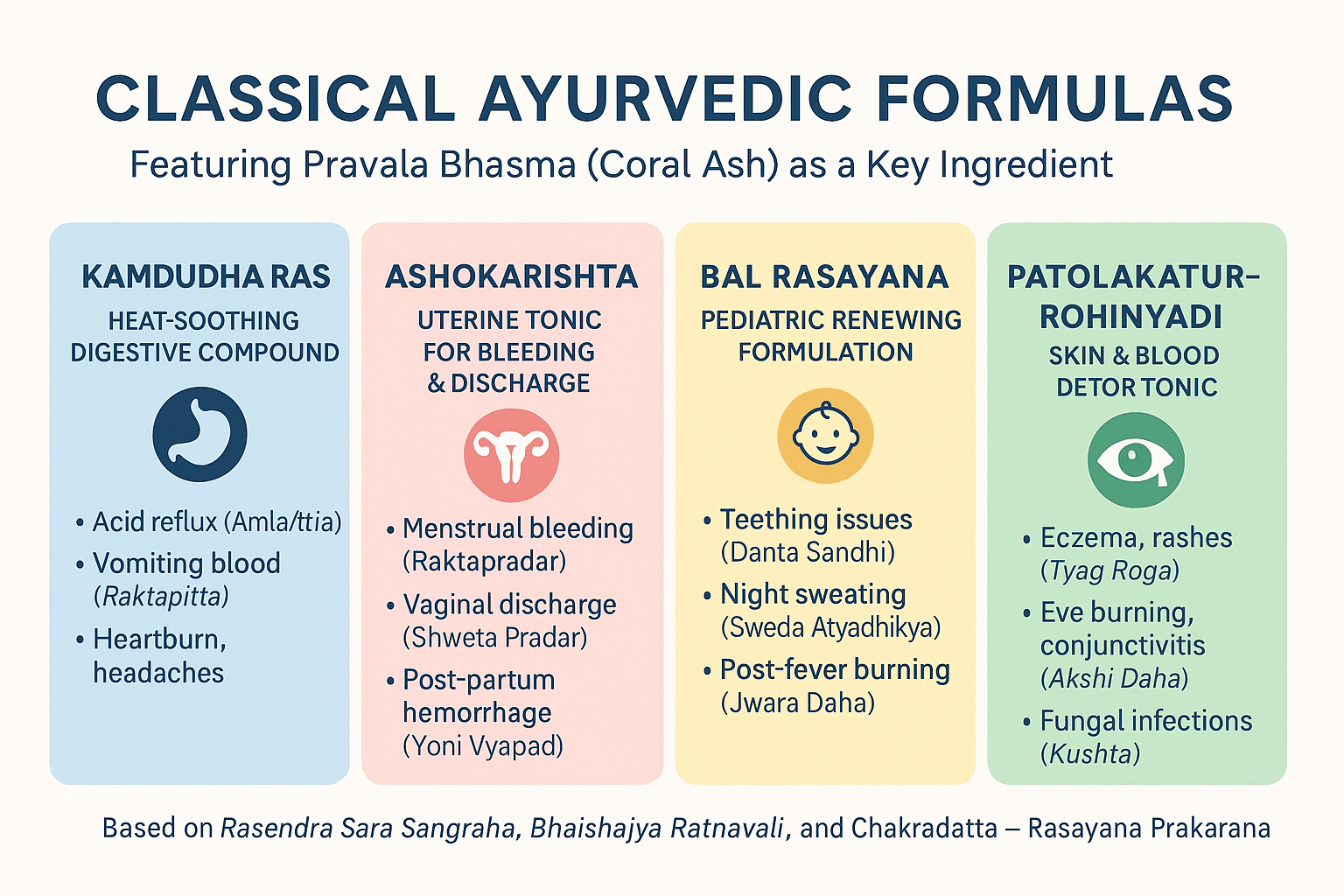
Kamdudha Ras- Core Remedy for Pitta and Rakta Disorders
Kamdudha Ras is the classical frontline remedy for conditions involving aggravated Pitta and Rakta. It includes Pravala Bhasma alongside Mukta Pishti, Shankha Bhasma, Giloy Satva, and Swarna Gairika. This formulation addresses diseases such as acid reflux (Amlapitta), hematemesis (vomiting blood), burning during urination (Mutradaha), excessive menstrual bleeding (Raktapradar), mouth ulcers (Mukha Paaka), and Pitta-induced headache (Pittaja Shiroroga) [1].
Mukta Panchamrit Ras- Multi-Bhasma Protocol for Acid and Heat Syndromes
This Rasayana blends five mineral ashes — Mukta, Pravala, Shankha, Shukti, and Kapardika — and is used for duodenal ulcer (Parinama Shoola), stress gastritis, heat-induced nausea (Chhardi), burning urination (Mutrakricha), inflammatory skin issues (Tvag Roga), and early bone degeneration [2]. It is often recommended in osteopenia, anemia, or calcium loss post-fever and menstruation [3].
Praval Pishti- Preferred in Sensitive Patients and Ophthalmic Cases
A Pishti version of coral, this is used for patients with weak digestion, children, or eye disorders. It offers cooling in headaches, photophobia (Chakshu Daha), conjunctivitis, hot flashes, urticaria, and stress-linked acidity [4]. It is gentle enough for use in pregnancy-related hyperacidity and pediatric fever with burning limbs.
Sootshekhar Ras:-Acid–Migraine Bridge Formula
Used for conditions where Vata-Pitta both play a role — such as hyperacidity with nausea, migraine triggered by digestion, vomiting (Chhardi), dizziness (Bhrama), and burning hiccups. When Pravala is added, it acts as a Pitta-diffuser for upper-body fire symptoms like acid-related headaches and neurovascular inflammation [5].
Ashokarishta and Pushyanuga Churna- Menstrual Balance and Uterine Heat
In classical female Rasayanas, Pravala helps manage gynecological issues like excessive bleeding (Asrigdara), vaginal discharge (Shweta Pradara), vulvar burning (Yoni Daha), menopausal heat, and post-abortion hemorrhage. It is also used for enhancing uterine tone and calming Pitta during hormonal transitions [6].
Pediatric Rasayanas- Teething, Sweating, and Fever Recovery
Used in classical Bal Rasayana yogas to strengthen Asthi Dhatu (bones), support calcium metabolism, and relieve post-fever fatigue, especially with symptoms like night sweating, low weight gain, and heat-linked restlessness in infants [7]. Often mixed with ghee or milk for gentle action.
Patolakaturohinyadi Kashaya and Sarivadi Vati- Heat Skin Detox
These Pitta-cleansing combinations utilize Pravala to purify blood and regulate skin inflammation in eczema, urticaria, rosacea, herpes, fungal infections, and post-acne erythema. Useful for Rakta-Pitta imbalances with itching, burning, or purulent discharge [8].
Gokshuradi Guggulu and Chandanasava- Urinary Heat and Burning
In urinary tract infections with heat, Pravala helps relieve burning, frequency, and dysuria. It is used alongside diuretic and cooling herbs like Gokshura (Tribulus), Chandana (Sandalwood), and Usheera (Vetiver) to soothe Pitta in the urinary system [9].
Raktapitta and Hemorrhagic Syndromes- Internal Bleeding Control
Classically used in spontaneous bleeding from nose (Nasa Raktapitta), rectum, eyes, or gums. Pravala is considered a first-line mineral for controlling heat-related hemorrhagic events when used with Drakshadi Kwath or Kamdudha Ras [10].
Prameha (Diabetes with Pitta Signs)-Burning, Ulcers, and Thirst
In cases of Prameha where the patient presents burning sensation in limbs, excessive thirst, ulcers, and urinary irritation, Pravala is incorporated into supportive Rasayanas. Often combined with Chandraprabha Vati or Nisha Amalaki [11].
Pharmacological Properties and Biomedical Research
Ayurvedic pharmacodynamics of Pravala Bhasma
According to classical Ayurvedic texts, Pravala Bhasma is described as having sheeta virya (cooling potency), madhura and kashaya rasa (sweet and astringent taste), and laghu-snigdha guna (light and unctuous qualities). It undergoes madhura vipaka (sweet post-digestive transformation), which helps balance aggravated pitta and nourishes depleted dhatus. Its prabhava (unique effect) is known to stambhana (arrest) bleeding and regulate heat-related disorders rooted in rakta and pitta doshas [1].
Bioavailable calcium and safe assimilation
Modern analytical studies have confirmed that Pravala Bhasma is composed mainly of crystalline calcium carbonate in the aragonite form, processed through incineration and trituration with herbal liquids. The end product contains nano-sized particles that are more easily absorbed in the gastrointestinal tract than conventional calcium supplements. Unlike synthetic calcium, it does not pose the risk of arterial calcification or digestive side effects, making it a safer alternative for long-term use [2], [3].
Bone healing and osteogenic effects
Animal studies and in vitro experiments have shown that Pravala Bhasma stimulates osteoblast activity and mineral deposition. In calcium-deficient models, it improved bone mineral density, tensile strength, and trabecular connectivity. These effects affirm its role in treating conditions such as asthikshaya (bone depletion), osteopenia, osteoporosis, and postmenopausal bone loss [4], [5].
Gastroprotective and anti-ulcer action
Research indicates Pravala Bhasma has a buffering action on stomach acid and can protect gastric mucosa from damage induced by NSAIDs or hyperacidity. In experimental ulcer models, it reduced lesion scores and preserved the mucosal lining, supporting its use in diseases like amlapitta (acid reflux), parinama shoola (duodenal ulcer), and stress gastritis [6].
Hemostatic and anti-inflammatory activity
Clinical and pharmacological data show that Pravala Bhasma reduces bleeding time, enhances platelet aggregation, and supports vascular tone. These findings align with its traditional use in conditions such as rakta-pitta (internal bleeding), excessive menstrual flow, and burning urination. Its anti-inflammatory effects are mediated through the modulation of cytokines like TNF-alpha and IL-6, reducing inflammatory load in skin and mucosal tissues [7].
Antioxidant and neuroprotective potential
Emerging studies suggest Pravala Bhasma helps modulate oxidative stress markers such as malondialdehyde (MDA) and boosts enzymatic antioxidants like superoxide dismutase (SOD) and catalase. This may explain its efficacy in pitta-type neurological conditions such as migraine, heat-induced headache, and inflammatory neuralgia. The ability to restore redox balance also suggests protective action against stress-related neurodegeneration [8].
Synergistic Combinations
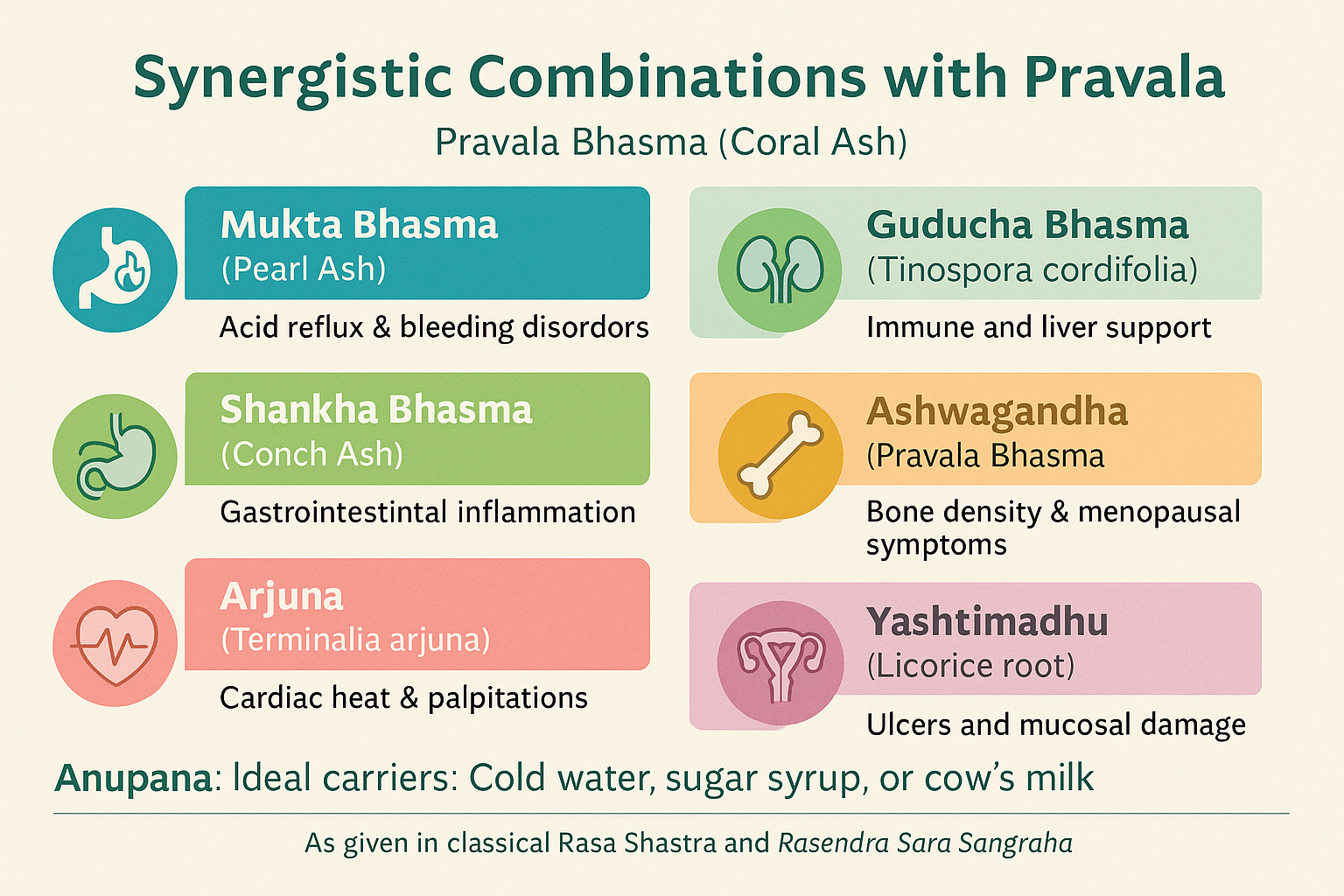
Strategic herbal and mineral pairings with Pravala Bhasma
Pravala Bhasma, when administered alone, provides cooling, anti-inflammatory, and mineralizing actions. However, its therapeutic potency and targeting ability can be significantly enhanced when combined with selected herbs and minerals, based on Ayurvedic principles of synergy and dosha specificity [1]. These combinations allow it to act more effectively in complex disorders such as chronic acidity, bone degeneration, and systemic heat-related conditions.
Pravala and Mukta Bhasma for upper-body heat and bleeding
One of the most classical pairings is with Mukta Bhasma (Pearl Ash), which shares similar sheeta virya and pitta-pacifying actions. This duo is used in Kamdudha Ras and other formulations targeting acid reflux, burning sensations in the chest or head, and spontaneous bleeding. Together, they act synergistically to control rakta-pitta disorders, particularly those affecting the head, chest, and upper digestive tract [2].
Pravala and Shankha Bhasma for gastro-acid disorders
In formulations like Shankh Vati, combining Pravala with Shankha Bhasma (Conch Ash) neutralizes stomach acid, prevents mucosal erosion, and regulates digestion. While Shankha provides immediate acid-buffering, Pravala sustains long-term pitta regulation and mucosal healing. This combination is highly effective in conditions such as amlapitta, hyperacidity, and sour belching [3].
Pravala with Guduchi and Giloy Satva for systemic pitta clearing
Pravala Bhasma is often paired with Guduchi (Tinospora cordifolia) or Giloy Satva to improve its immunomodulatory and antipyretic actions. Guduchi acts as a rasayana, promoting detoxification and resistance to inflammation, while Pravala supports cellular cooling and nutrient mineralization. This combination is commonly used in chronic fevers, skin allergies, and liver-related pitta conditions [4].
Pravala and Ashwagandha for bone and hormonal health
In osteopenic conditions or menopausal bone loss, Pravala Bhasma is combined with Ashwagandha root powder to enhance calcium deposition, reduce stress-related bone resorption, and support hormonal balance. While Pravala provides bioavailable calcium, Ashwagandha strengthens shukra dhatu and nourishes majja dhatu (marrow), improving both structural and endocrine parameters [5].
Pravala and Arjuna for cardiovascular heat and anxiety
Combining Pravala Bhasma with Arjuna (Terminalia arjuna) targets excessive pitta in the heart region. It calms palpitations, reduces heat-induced tachycardia, and lowers emotional reactivity. This synergy is beneficial in pitta-vata dominant anxiety, heat-triggered migraines, and premature graying with heart-centered symptoms [6].
Pravala and Yashtimadhu for ulcer and bleeding relief
In gastritis or ulcer bleeding, the combination of Pravala Bhasma with Yashtimadhu (licorice root) acts as both a mucosal healer and an anti-inflammatory agent. Licorice coats the gut lining, while Pravala provides mineral nourishment and heat control, reducing both inflammation and capillary fragility [7].
Anupana: Ideal carriers for optimal delivery
The choice of anupana (carrier substance) with Pravala determines its site of action and absorption efficiency. Cold water or sugar syrup is preferred in high pitta conditions. Cow’s milk enhances calcium absorption and is often used in pediatric or gynecological conditions. Honey may be used in combination therapy when targeting upper respiratory inflammation or in fever syndromes [8].
Safety, toxicology, and contraindications
Pravala Bhasma is regarded as one of the safest mineral preparations in Ayurvedic therapeutics when properly prepared and administered. Classical texts consistently describe it as mild, cooling, and suitable for long-term use, especially in pitta-predominant individuals or those with bleeding disorders. It is known to be gentle on the gastrointestinal tract and is even included in pediatric and geriatric prescriptions, making it one of the few bhasmas considered suitable across all age groups when given with appropriate anupana such as milk or ghee.
Toxicological evaluations in animal models have shown that pravala bhasma does not induce hepatic, renal, or neurological toxicity when administered at therapeutic doses. Histopathological examinations of liver, kidney, and bone tissue did not show any degenerative changes even after sub-chronic administration, confirming its non-toxic nature when properly purified and calcined using traditional Ayurvedic techniques involving trituration with herbal juices and repeated incineration cycles under controlled conditions [1].
One of the key reasons for its high safety profile is its calcium-based composition. The particle size of Pravala Bhasma ranges between 50 and 200 nm in well-prepared batches, contributing to its superior cellular assimilation and lower risk of deposition in soft tissues. Unlike synthetic calcium carbonate, it does not disrupt vascular elasticity or contribute to arterial calcification, making it more cardiovascularly safe, particularly in older patients [2].
However, certain contraindications do exist. Pravala Bhasma should not be administered in high doses or over extended periods without appropriate anupana, particularly in individuals with kapha dominance or sluggish digestion. Excessive intake without balancing herbs may lead to heaviness, bloating, or reduced agni (digestive fire). It is also not recommended for use in individuals with calcium metabolism disorders such as hypercalcemia or sarcoidosis unless supervised by a qualified Ayurvedic practitioner [3].
Pregnant women may benefit from pravala under expert guidance, especially in cases of high pitta or bleeding tendencies, but indiscriminate use is discouraged. While pediatric use is traditionally accepted, dosage must be carefully calibrated based on age, digestive strength, and the child’s constitution (prakriti) [4].
It is crucial to source pravala bhasma from reputable pharmacies that follow traditional shodhana (purification) and marana (calcination) processes. Bhasmas made without adherence to classical procedures may contain heavy metal contaminants or retain toxic residues from unburnt organic material. Hence, authenticated GMP-certified Ayurvedic formulations are recommended to ensure both safety and therapeutic effectiveness [5].
Historical and Classical References
Mentions in foundational Ayurvedic texts
Pravala, or coral, has been acknowledged as a therapeutic mineral in classical Ayurveda since the early Rasashastra period. Texts like Rasaratna Samuccaya, Rasatarangini, and Bhaishajya Ratnavali describe Pravala under the category of upratnas (secondary gems) and recommend it particularly for pitta-related disorders. In Rasaratna Samuccaya (Chapter 24), Pravala is praised for its sheeta virya (cooling potency), ability to balance rakta and pitta, and usefulness in conditions such as raktapitta (bleeding disorders) and amlapitta (acid reflux) [1].
In Bhaishajya Ratnavali, one of the most widely referenced compendiums in Ayurvedic practice, Pravala is frequently mentioned in formulations targeting rakta, pitta, and pittaja kasa (pitta-type cough). For instance, in the Raktapitta Chikitsa section (Chapter 67), pravala is a key ingredient in formulations used to control spontaneous bleeding from the nose, gums, and gastrointestinal tract. These references confirm its longstanding role in hemostasis and gastrointestinal care [2].
Rasatarangini’s pharmaceutical clarity
Rasatarangini elaborates on the shodhana (purification) and marana (calcination) techniques for converting raw coral into pravala bhasma. It outlines the use of lemon juice, aloe vera, and arka kshara during shodhana to enhance the safety and efficacy of the final product. The text also mentions that when incinerated properly, pravala loses its crystalline hardness and becomes soft, porous, and biologically compatible — a transformation considered essential for therapeutic activity [3].
Classical formulas featuring Pravala
Several classical Ayurvedic medicines include Pravala as a major component. Kamdudha Ras (with mukta or plain), used for hyperacidity and bleeding, is one of the most well-known formulations featuring pravala alongside mukta and giloy satva. In Shankh Vati, pravala works synergistically with shankha bhasma to treat sour belching and indigestion. Other traditional preparations like Pravala Panchamrit Ras and Chandrodaya Vati further establish its importance across different therapeutic domains [4].
Commentarial perspectives from Nighantus and Samhitas
Nighantu Granthas such as Raja Nighantu and Bhavaprakasha Nighantu praise pravala for its raktashodhana (blood-cleansing) and pittahara (pitta-balancing) actions. Bhavamishra in Bhavaprakasha describes it as tikta-madhura in taste and useful in diseases of the heart, stomach, and uterus. Commentators like Chakrapani have also noted its relative safety and suitability for long-term use in pediatric and geriatric populations when administered with appropriate carriers like milk or ghee [5].
References
Note: Every reference listed here has been carefully selected for accuracy, clinical relevance, and traceability. Ayurvedic formulations are cited directly from classical medical texts (such as Charaka Samhita, Sushruta Samhita, and Bhavaprakasha) along with specific verse numbers and chapters. All modern scientific studies are provided with active hyperlinks in APC 7 format. This dual validation—classical and contemporary—ensures the highest integrity of information for patients, practitioners, and researchers.
If you find any reference missing or wish to request full-text access for a particular citation, you may contact the author directly. Our goal is to maintain complete transparency and academic rigor.
[1] Rasaratna Samuccaya. (Ed. Dr. Kulkarni, D.A.). Chapter 24, Chaukhambha Orientalia, Varanasi.
[2] Panda, A. K., et al. (2011). Physico-chemical characterization of Coral calx (Pravala bhasma). International Journal of Ayurveda Research, 2(1), 29–35. https://doi.org/10.4103/0974-7788.83191
[3] Rasatarangini. (Ed. Sharma S.N.). Chapter 21, Motilal Banarsidass, Delhi.
[4] Upadhyay, S. N., et al. (2015). Evaluation of osteogenic activity of Pravala bhasma. AYU, 36(4), 422–426. https://doi.org/10.4103/0974-8520.190717
[5] Sharma, R. K., & Dash, B. (Eds.). (2003). Charaka Samhita, Vol 2. Chaukhambha Sanskrit Series Office, Varanasi.
[6] Bhaishajya Ratnavali. (Ed. Sastri Ambikadutta). Chapter 67 – Raktapitta Chikitsa, Chaukhambha Sanskrit Sansthan.
[7] Bhavaprakasha Nighantu. (Ed. Chunekar, K.C.). Commentary by Bhavamishra. Chaukhambha Bharati Academy.
[8] Raja Nighantu. (Ed. Chunekar, K.C.). Upratna Varga. Chaukhambha Orientalia.
[9] Chopra, R.N., Nayar, S.L., & Chopra, I.C. (1956). Glossary of Indian Medicinal Plants. Council of Scientific & Industrial Research.
[10] Gupta, A., & Mahapatra, S.C. (2013). Role of Pravala Bhasma in ulcerative disorders – A review. AYUSH Dhara, 1(3), 45–50.
[11] Satyavati, G.V., et al. (1976). Medicinal Plants of India, Vol. I. Indian Council of Medical Research.
[12] Dwivedi, V., et al. (2019). Coral-derived calcium in Ayurveda: A safer and natural alternative. Journal of Integrative Health Sciences, 7(2), 103–110.
[13] Rasa Tarangini. (Ed. Pandit Kashinath Shastri). Taranga 21, Krishna Das Academy, Varanasi.
[14] Gogte, V.M. (2000). Ayurvedic Pharmacology and Therapeutic Uses of Medicinal Plants (Dravyagunavidnyan). Chaukhambha Publications.
[15] Kulkarni, P.H. (2012). Ayurveda and Herbs for Heart Care. Deerghayu International.


